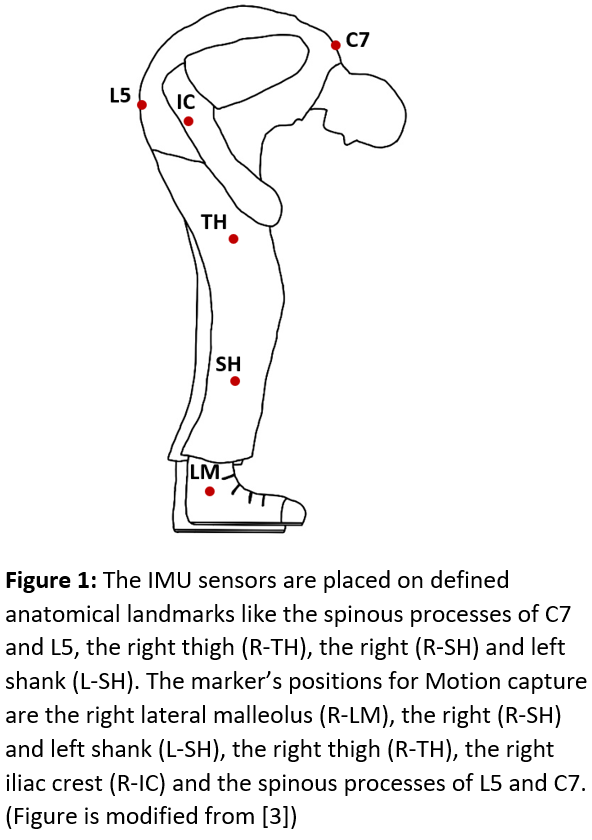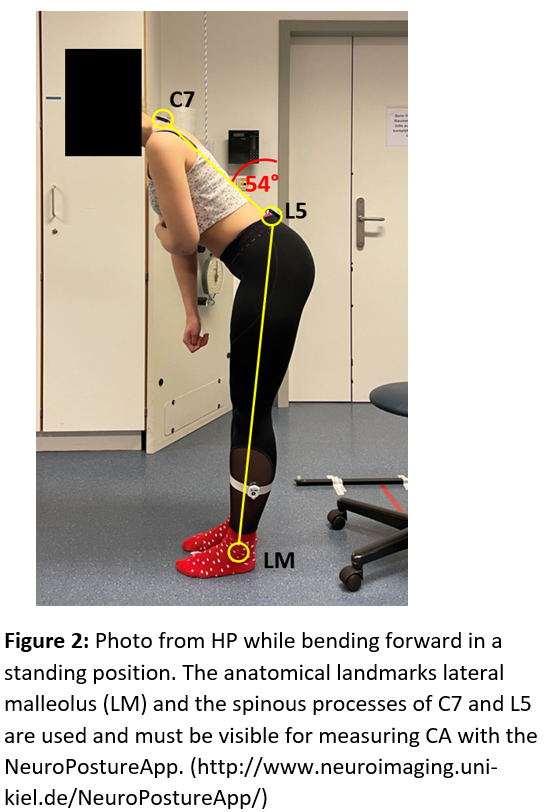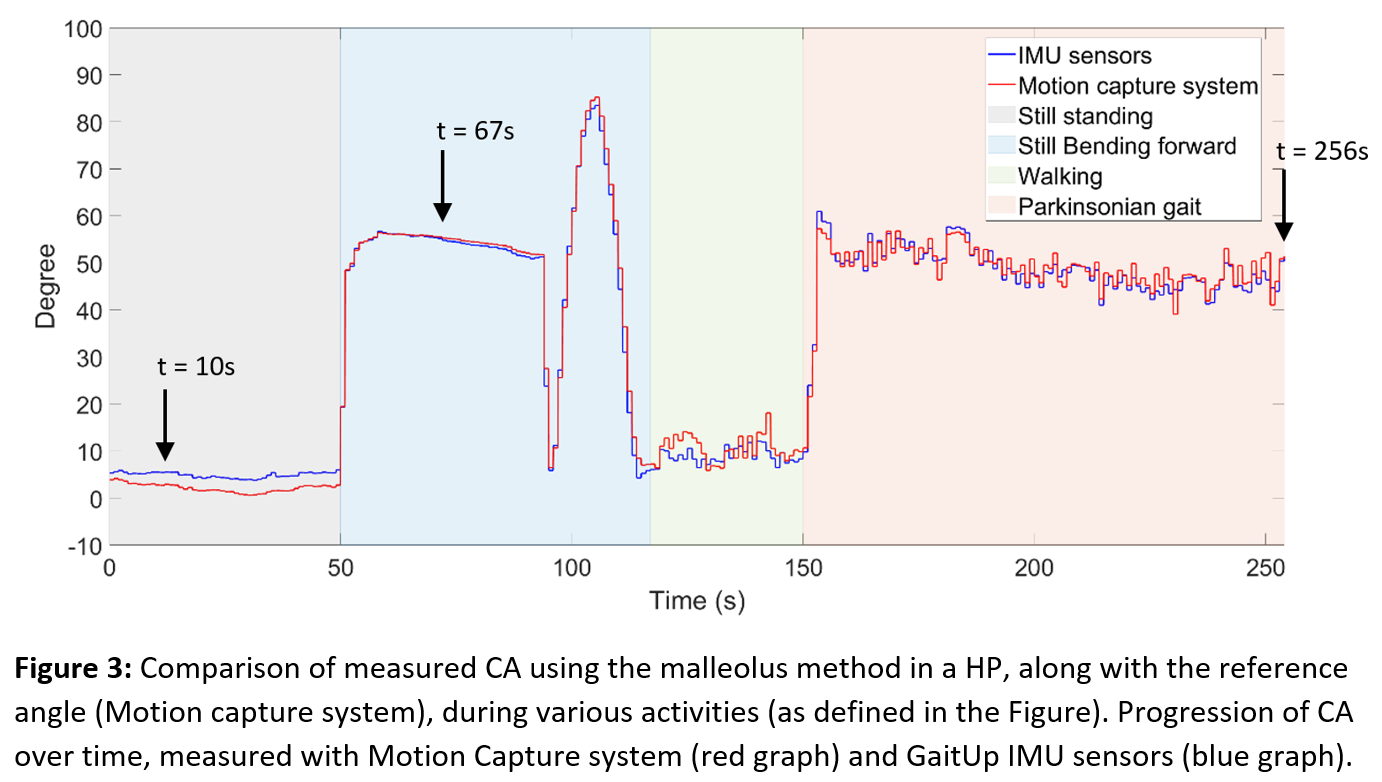Category: Parkinson's Disease: Non-Motor Symptoms
Objective: To implement inertial-measurement-unit (IMU) sensors as a reliable and valid diagnostic tool in assessing the camptocormia angle (CA).
Background: Camptocormia is a pathological non-fixed trunk flexion, which resolves when lying down. IMU sensors can record longer periods of time and doing, so they can reduce the awareness of the patient being assessed, what might help to reduce correction efforts. The GaitUp system has qualified as a very good option in a previous study [1]. We aim to make angular measurements based on the malleolus method, since the only empirically based CA has been defined for this method to date.
Method: A forward bending angle of more than 30° according to the malleolus method is defined as a reliable sign for camptocormia [2][3]. Our IMU sensor system (GaitUp) consists of five sensors (Figure 1). Two already proven quantitative measurement methods will be compared with the new IMU sensor system: (1) the Motion capture system that need six markers (Figure 1) and (2) the NeuroPostureApp that needs three landmarks C7, L5 and lateral malleolus (Figure 2). Healthy participants (HP) mimicking a camptocormia body posture and PD patients with camptocormia will be assessed.
Results: The results of a measurement with a HP are shown in Figure 3 and Table 1. The accuracy of the IMU sensors is highest when standing. During the other activities, an average difference of 1,62° in walking and 0,52° in Parkinsonian gait can be seen in Figure 3. The overall average difference is 0,08°. In standing the offset is caused by a negative leg angle. Walking complicates the evaluation, although good values can still be achieved using our self-developed algorithm. Furthermore, the CAs of the IMU sensors are most consistent with the data of Motion Capture, which we use as a reference, compared to those of NeuroPostureApp (Table 1).
Conclusion: The CAs of the IMU sensors predominantly agree with those of the motion capture system and NeuroPostureApp. According to our preliminary data the IMU sensor system is capable to assess in a reliable and valid manner the dynamic CA in standing and walking participants in different degrees of flexion. The IMU sensors are superior to the NeuroPostureApp because they can detect tilts in any directions and therefore are more precise. The results of more HP and PD patients will be available at the congress.
References: [1] R. Wolke, K. Naderi Beni, H. Wolframm, R. Rieger, N. Margraf. Conception of a sensor- and home-based measurement of camptocormia [abstract]. Mov Disord. 2021; 36 (suppl 1). https://www.mdsabstracts.org/abstract/conception-of-a-sensor-and-home-based-measurement-of-camptocormia/. Accessed March 13, 2023.
[2] Schlenstedt C, Boße K, Gavriliuc O, Wolke R, Granert O, Deuschl G, Margraf NG. Quantitative assessment of posture in healthy controls and patients with Parkinson’s disease. Parkinsonism Relat Disord. 2020 Jul;76:85-90. doi: 10.1016/j.parkreldis.2020.01.012. Epub 2020 Jan 28. PMID: 32033879.
[3] Margraf NG, Wolke R, Granert O, Berardelli A, Bloem BR, Djaldetti R, Espay AJ, Fasano A, Furusawa Y, Giladi N, Hallett M, Jankovic J, Murata M, Tinazzi M, Volkmann J, Berg D, Deuschl G. Consensus for the measurement of the camptocormia angle in the standing patient. Parkinsonism Relat Disord. 2018 Jul;52:1-5. doi: 10.1016/j.parkreldis.2018.06.013. Epub 2018 Jun 8. PMID: 29907329.
To cite this abstract in AMA style:
K. Knutzen, K. Naderi Beni, R. Wolke, J. Kuhtz-Buschbeck, R. Rieger, NG. Margraf. First approach of a sensor-based assessment of the camptocormia angle [abstract]. Mov Disord. 2023; 38 (suppl 1). https://www.mdsabstracts.org/abstract/first-approach-of-a-sensor-based-assessment-of-the-camptocormia-angle/. Accessed December 12, 2025.« Back to 2023 International Congress
MDS Abstracts - https://www.mdsabstracts.org/abstract/first-approach-of-a-sensor-based-assessment-of-the-camptocormia-angle/




